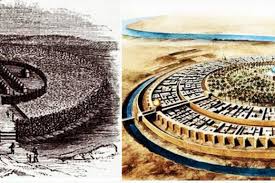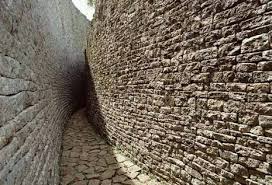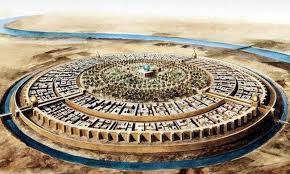Benin City Walls; Benin City, the capital of Edo State in southern Nigeria, is home to one of Africa’s most remarkable architectural and historical
wonders—the Benin City Walls. These ancient walls, a testament to the ingenuity and sophistication of the Benin Empire, are
steeped in rich history and cultural significance.
Today, the remnants of the Benin City Walls serve as a poignant reminder of the region’s rich history and cultural heritage.
Efforts are made to preserve and restore parts of the walls , although much has been lost to urbanization and erosion.
A Glimpse Into History
The Benin Moat (Edo: Iyanuwo), also known as the Benin Iya, or Walls of Benin, is a series of massive earthworks encircling
Benin City in Nigeria’s Edo State. These moats have deep historical roots, with evidence suggesting their existence before
the establishment of the Oba Monarchy. Construction began around 800 AD and continued until 1460 AD, involving
large-scale manual labor and the repurposing of earth from the inner ditch to build the outer berm. Some traditional sources
claim that these earthworks spanned approximately 16,000 kilometers (9,900 mi), enclosing about 6,500 square kilometers
(2,500 sq mi) of land.
A short Video on the walls of benin: https://www.tiktok.com/@ultradigitalwave/video/7212283815367118086?lang=en
The Benin City Walls constructed between the 13th and 15th centuries during the height of the Benin Empire, one of
Africa’s oldest and most advanced civilizations. The walls, known locally as “Iya,” were built to protect the city from invasions
and to control the movement of people and goods. They stand as a symbol of the empire’s power and engineering prowess.
The walls composed of a combination of ramparts (large embankments of earth) and
moats (deep ditches), designed to protect
the city from invaders and to control access. The main wall system enclosed the heart of Benin City, including the royal palace,
residential areas, and markets. Statistics estimate that the walls stretched over 16,000 kilometers,
making them one of the largest man-made structures in history.
Engineering and Labor
The construction of the Benin City Walls was a monumental task that involved extensive manual labor. The earthworks were
built by digging out the earth to form deep moats and using the excavated soil to create high embankments. This process
required the coordinated efforts of thousands of workers over several centuries, reflecting the advanced organizational skills
of the Benin Empire.
Historical Significance
The walls were not just defensive structures; they also symbolized the power and sophistication of the Benin Empire. The walls
enclosed an area where complex administrative and social systems were in place, showcasing the empire’s high level of urban
planning and governance. The Benin Empire was known for its artistic achievements, particularly in bronze casting, and the walls
were part of this cultural and technological milieu.
Features


Architectural Feat
The walls comprised a series of earthworks made from a combination of moats and ramparts. The main wall was estimated to
be about 16,000 kilometers in length, making it one of the largest man-made structures in the world, often compared to the
Great Wall of China in terms of its scale. The height of the walls varied, with some sections reaching up to 20 feet high.
Construction Techniques
The construction of the Benin City Walls was a massive undertaking that involved the manual excavation of earth and the strategic
placement of the excavated soil to form the ramparts. The moats, some of which were filled with water, added an extra layer of defense. The entire project was a community effort, showcasing the collective labor and cooperation of the Benin people.
Visiting the Benin City Walls
For visitors to Edo State, the Benin City Walls offer a fascinating glimpse into the past. Guided tours provide insights into the history
and significance of the walls, allowing visitors to appreciate the scale and craftsmanship of this ancient structure. The nearby
National Museum in Benin City also offers a wealth of artifacts and exhibits related to the Benin Empire, enhancing the historical experience.
The National Museum of Benin City: This museum houses a vast collection of artifacts, including the famous Benin Bronzes,
terracotta figures, and other relics that highlight the artistic and historical legacy of the Benin Kingdom.
The Royal Palace of the Oba of Benin: The palace is a central symbol of the Benin monarchy and an important cultural site. Visitors learn about the history and traditions of the Benin royal family, although access may be restricted.
Igun Street: The home of the bronze casters, the street lined with workshops
where artisans continue the centuries-old tradition of bronze casting. Visitors can watch the
craftsmen at work and purchase unique artworks directly from the source.
In Conclusion
The Benin City Walls stand as a monumental achievement in African history and architecture. They embody the legacy of the
Benin Empire and its contributions to world heritage.
Exploring the walls is not just a journey into Nigeria’s past but also an opportunity to celebrate the ingenuity and resilience of its people.
Benin City offers a captivating journey through time, from its ancient roots as the capital of a powerful empire to its present-day
status as a cultural and economic hub. Whether you’re exploring historical sites, admiring world-renowned art, or immersing
yourself in the lively atmosphere of its markets and streets, Benin City promises an enriching and unforgettable experience.
Read More: https://placesandlifestyle.com/exploring-the-magnificence-of-the-great-wall-of-china/




